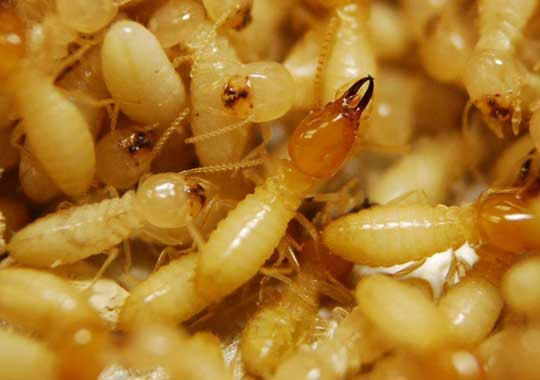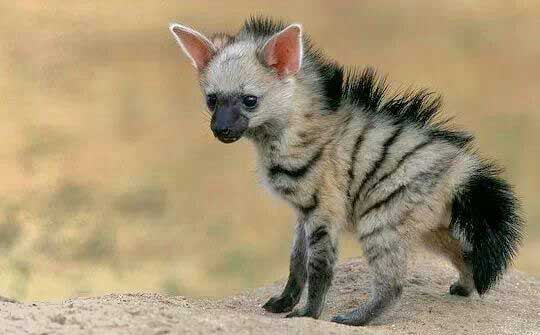|
Okay, I have to admit I chose this animal simply because I think it has a cool name: aardwolf. That, and the fact that few people know much about it. Then the more I looked into this unique creature, the more I realized it is truly awesome. What the heck is an Aardwolf? The name aardwolf is derived from Afrikaans and Dutch, and it literally means "earth wolf." There are two isolated populations that live in South Africa and East Africa. The aardwolf is in the same family with hyenas (Hyaenidae), but it split off from the hyenas long ago and is classified in a different subfamily (Protelinae). At first glance, the aardwolf looks similar to a striped hyena, but aardwolves are unique among cat-like and dog-like carnivores because they do not prey on large animals or carrion. Instead, they feed on insects! Amazing facts about the Aardwolf Aardwolves are much smaller than hyenas. Hyenas typically weigh between 60 pounds and 190 pounds (86 kg to 27 kg), whereas aardwolves weigh only 15 to 30 pounds (6.8 to 13.6 kg). They are more the size of lap dogs or domestic cats (only slightly larger than foxes). By the way, in the Hyaenidae family, there are three species of hyenas and one species of aardwolf. Aardwolves have five toes on their front feet and four toes on the their hind feet, whereas hyenas have four toes on all their feet. Also, surprisingly, hyenas and aardwolves are more closely related to felines (cats) than to dogs. Okay, let's talk about this insectivorous lifestyle. Aardwolves eat insects almost exclusively. Especially termites. They will eat small mammals and birds only as a last resort. They are sometimes seen hunkered over the carcass of a large dead animal, but they are not eating the dead animal—they are eating the insects and insect larvae that are feeding on the carcass. Ready to be impressed? Aardwolves love termites. They love them so much that they can eat 300,000 in one night! Check out the yummy-looking termites below. Don't you wish you could slurp up 300,000 of those tasty morsels every night? Just in case you don't fully appreciate the aardwolf's dedication to exclusively eating insects... when the weather turns cold and the termites and other insects become inactive, the aardwolf, instead of switching to other prey, will simply wait. They often lose up to 20% of their body mass because they choose to wait for those delicious bugs to become available again. Basically, they go on a hunger strike until they get what they want. How do they eat so many termites? Well, the unrelated aardvark likes to tear into termite mounds and stick its long, sticky tongue down into the termite burrows. The aardwolf, on the other hand, takes a simpler approach. It doesn't tear up the termite mound at all. Instead, it simply licks the termites off the ground as they emerge from the nest. Aardwolves hunt at night when termites are more likely to emerge from their nests. Aardwolves have excellent hearing and a keen sense of smell. Not only can they smell termites from a distance (a specific scent secreted by soldier termites), they can actually hear large groups of termites crawling in the grass. They simply walk up to them and lap them up with their sticky, bristly tongue. Since aardwolves don't destroy the termite mounds, they can return to the mounds every few months to feed on them again. They have a knack for remembering the locations of the most productive mounds. Aardwolves usually forage by themselves, for the simple reason that their unique food source is too scarce to allow them to forage in groups. Check out this brief video about the aardwolf. Like the hyenas, the aardwolf has a shaggy mane of hair along the ridge of its back. Since the aardwolf is not large, and since it is not a particularly fierce fighter, one way that it defends itself is to contract the tiny muscles that raise this glorious mane to full height. This is supposed to intimidate threatening predators such as lions and leopards. Hmm... a 20-pound critter with a mohawk. Doesn't seem that intimidating to me. If the upright mane doesn't work, there's always Plan B. For an aardwolf, Plan B is to squirt out this nasty-smelling stuff from the anal glands—stuff that is almost as smelly as a skunk's spray. Now that's intimidating! Aardwolves have an interesting social life. I've already mentioned that they go out at night and forage alone, due to necessity. But during the daylight hours they live in small family groups in burrows. Aardwolves' front legs are too weak to dig, so instead of digging their own burrows, they take up residence in the abandoned burrows of aardvarks. An added bonus of this is that aardvark burrows are almost always situated in areas with plenty of termite mounds (aardvarks eat termites too). Aardwolves are blatant cheaters. Their family groups are considered monogamous... socially monogamous but not really sexually monogamous. Two parents live in a den with several offspring. The two parents often live together for their entire lives. But (and this is a big but), there is usually significant shenanigans going on in the dark of night. The adults frequently travel to other dens and engage in some hanky-panky. In fact, one study showed that 62% of copulations were not even between mated individuals. But in spite of this constant cheating, the pair usually continues to live together. Out of each litter of 2 to 4 babies, typically at least one is the live-in father's offspring. Regardless of who the father is, baby aardwolves are pretty darn cute. So, the aardwolf deserves a place in the N.A.H.O.F. (Nonpareil Animal Hall of Fame). FUN FACT: The word nonpareil was first used in the early 1400s and can be traced back to a Middle French origin. It was an adjective that literally meant "not equal." But since the late 1500s, it has commonly been used as a noun to describe an individual of unequaled excellence—he or she is one of a kind. In 1612, Captain John Smith used the word as a noun (with an archaic spelling): "Pocahontas, Powhatan's daughter... was the very Nomparell of his kingdome, and at most not past 13 or 14 years of age." Oddly, the word also means "a small pellet of colored sugar for decorating candy, cake, and cookies." And it is the name of a type of chocolate candy covered with bits of sugar. So, when used as an adjective, nonpareil is another way to say awesome! Photo Credits:
Spiny orb-weaver spider - Wikipedia Aardwolf #1` - https://www.britannica.com/animal/aardwolf/media/1/257/183802 Termites - Thomas Chouvenc via Entomology Today Aardwolf tongue - Tambako The Jaguar via Flickr Aardwolf mane - Pinterest Baby Aardwolf - Reddit
5 Comments
Leilani
2/7/2021 08:50:17 pm
I actually use this page as a game on google. The image of a striped hyena from this post shows up if you google "aardwolf". I have people guess which one is the striped hyena of the results. xD
Reply
Rosemary
2/25/2021 10:36:06 am
Oh wow same. 😝
Reply
Thomas Venuto
2/22/2024 03:31:24 pm
I hate these stupid animals, they keep eating my slippers
Reply
3/4/2024 03:48:29 pm
You Idiot, that clearly isn't part of their natural diet, if they keep "eating your slippers" as you say, then stop buying them, you are causing harm to them and that is clearly unforgivable, maybe you should start eating rocks tipped with a deadly poison to feel how they do.
Reply
Jacob Wright
3/4/2024 03:53:54 pm
Hey, that's not very nice, imagine how you would feel after your slippers are being constantly eaten and then you get some random guy telling you to kill yourself? who gives you the right to say that Leave a Reply. |
Stan's Cogitations
Everyone needs a creative outlet. That's why I write. Archives
July 2024
|






 RSS Feed
RSS Feed